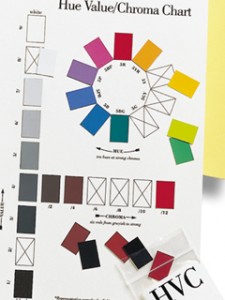
Carole R. Brown has been a color theory instructor at the Art Institute of California for over 10 years. She joins us to talks about her hands-on approach to teaching. Her Color a Day Blog is a visual and informational mash of traditional and personal color concepts and theory observations.
Color Theory Basics Brought to Life
“Yell ‘Bingo’ as soon as all the chips are in order – you’ll know when it’s right,” I announce.
Are these gambling chips? No.
Is the place a casino? No.
In fact, the chips are from the workbook “The Munsell Color System: A Language for Color” and the place is my classroom on the last day of an eleven week college Color Theory course at the Art Institute of California. The book is just one of several Munsell color theory books that have shaped the color industry for decades. Terrifically useful, and fun too!
Teaching color theory is both a challenge and rewarding. By the final week of a given quarter, my students are well versed in all the important color theories from the Renaissance to the present including the Munsell Color System, which was invented by the American painter and educator Albert Henry Munsell.
So then it’s time to have some fun and see what they’ve learned.
“Okay class,” I instruct, “break into teams of four and select one of the 10 color chip packs and start to organize your hue by value and chroma.”
Having mixed and matched color schemes and color palettes throughout the quarter, students are already well versed in the Munsell Color System terminology of Hue, Value and Chroma.
Each teams shakes out the chips from a plastic pack onto a graphed chart. “Make sure all the chips are there – the number is notated on the pack,” I warn.
“Don’t be dismayed by the jumble of color chips,” I cajole. “First, sort out all the desaturated hues, the ones that are nearly achromatic. Next, build the left column as values, starting with the darkest values at the bottom. Only place the chips on the X marked squares – and please do not glue them down.”
Hands on Approach to Teaching Color Theory
As I look out at the classroom, all four teams are sliding and slipping their selected chips around the graphed charts. Color patterns began to gel. In no time, each hue reveals a logical blend of values and chroma. The Green team is first to shout “Bingo.”
Soon after, almost all the teams echo “Bingo” . . . except for one: the YR team is stuck. Why is there an open X marked square?
Carefully a count is made and, as notated on the color pack, all 22 chips are there. Minutes later the error is caught: the misaligned chip is covering a blank square. Students quickly reposition the chip to cover instead the one remaining X square.
At last, the YR team yells, “Bingo.”



Great blog, Carole. Let’s play sometime!
Cool Carol
Great idea!
Where can I purchase several of these kits